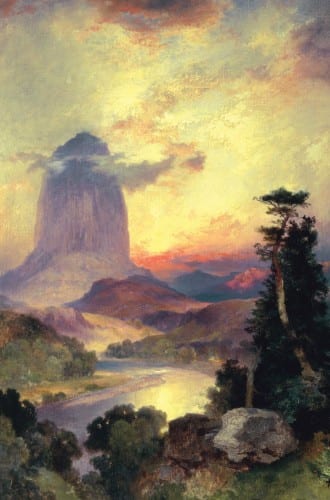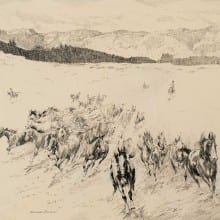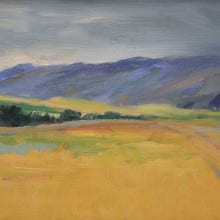June 15, 2015 @ 2:00 am - September 7, 2015 @ 11:00 am
Boots, Brushes and The Bighorn Mountains exhibit is the brainchild of The Brinton’s chief curator and executive director, Ken Schuster. A long time in the making, it has only just become possible to achieve through the building of The Brinton Museum’s new 24,000 square-foot Forrest E. Mars, Jr. Building. With climate controlled galleries and a vast amount of space, The Brinton can now bring together some of its most iconic works of Western art, as well as many important loaned treasures, each of which were inspired by the majesty of the Bighorn Mountains.

This exhibit reflects upon the importance of remembering where The Brinton started by featuring artists who inspired the museum’s original collection. Works within this exhibit range in date from the 1860s to the late 1930s and include Thomas Moran, Hans Kleiber, Bill Gollings, Frederic Remington, Joseph Henry Sharp, WHD Koerner and William Henry Jackson, to name just a few. Whether it’s in the placid valleys of Kleiber’s paintings, the snowfalls and horses of Gollings’ drawings, or the plains and ridges of Sharp’s oils, this special exhibition reflects the heart of Bradford Brinton’s vision.
While Sheridan and Big Horn, Wyoming are different than they were during the lives of these artists, looking out from the terrace of the new Forrest E. Mars Jr. Building today reveals the mountains to be comfortingly similar to their portrayal in these 19th and early 20th Century works. The static beauty of the Bighorn Mountains and the art that celebrates them remind us that nature is a monumental force in an ever-changing world.
“The artists and their works exhibited in this show extracted a diverse body of images from the Bighorns for us to enjoy and ponder as we walk through this gallery nestled into this gentle hillside that is part of the mountains themselves.
Ken Schuster
Director & Chief Curator
 Edward Borein, Wild Horse Round Up
Edward Borein, Wild Horse Round Up
Featured Artist
Edward Borein (1872-1945)
Edward Borein was born in the San Francisco Bay area. When he was just 21 years old, he rode south to work as a cowpuncher in southern California and across Mexico. While on the range, he sketched from the saddle, documenting his life as a cowboy. By 1900, after about 7 years on the range, he moved back to Oakland to set up a studio, and in 1907 he moved to New York to pursue his art career full time. His portrayals of Western life gained great popularity in the East and he found consistent work as an illustrator. In 1921 he returned to California and established a studio in Santa Barbara. A tireless worker, Borein produced over 300 different etchings, documenting the West from the Wyoming mountains to the pueblos of the Southwest.
A good friend of Bradford Brinton’s, the two likely connected in Big Horn through the Gallatins who became acquainted with Borein in New York. Around 1927-28 he painted the frieze in the living room of the Quarter Circle A Ranch House with scenes from local area history. He also frequently made custom Christmas cards for Brinton. Borein’s sensitive and detailed etchings show not only the unique geography of the West and Southwest, but also extreme care in depicting accurately the life of the people in these regions, from the intensity of bronc busters at local rodeos to the contemplative faces of Indian women.
 Storm Coming Down
Storm Coming Down
Featured Artist
Fra Dana (1875-1948)
Fra Broadwell Dinwiddie Dana (pronounced ‘Fray’, after her grandfather Samuel “Franklin” Maxwell) was one of the leading artists of the Rocky Mountain Northwest at the turn of the 20th century. Her characteristic style of Impressionism developed through friendships with notable American artists such as Joseph Henry Sharp, William Merritt Chase and Alfred Henry Maurer.

